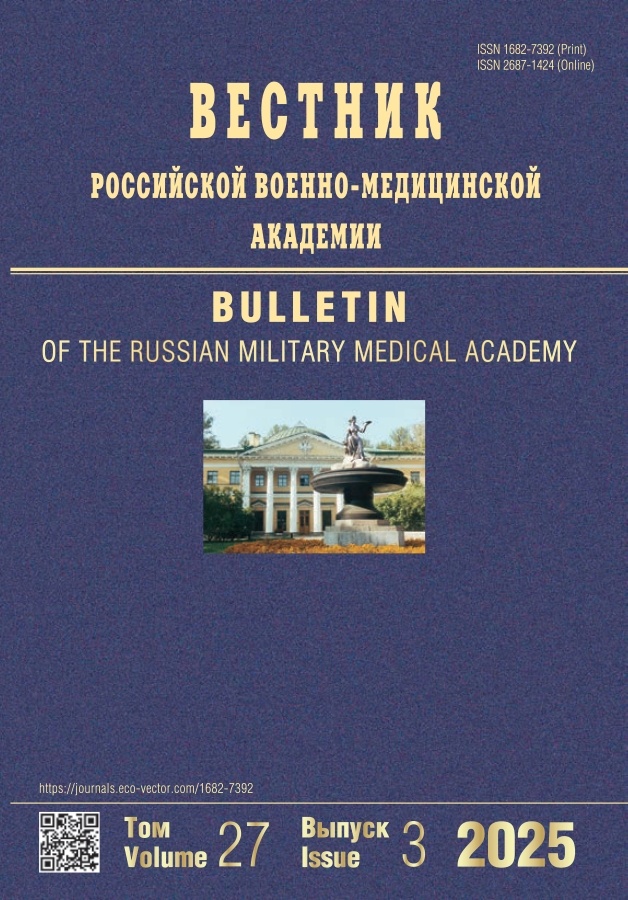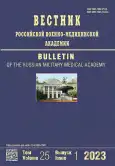Features of the anatomical structure of the wedge-shaped sinus in various age periods in children and in adolescence
- 作者: Gaivoronsky I.V.1,2, Markeeva M.V.3, Aleshkina O.Y.4, Tarasova N.V.3, Gaivoronsky A.I.1, Kochetygova O.V.5
-
隶属关系:
- Kirov Military Medical Academy
- Saint Petersburg State University
- Volgograd State Medical University
- Saratov State Medical University named after V.I. Razumovsky
- Yuri Gagarin State Technical University of Saratov
- 期: 卷 25, 编号 1 (2023)
- 页面: 77-84
- 栏目: Original Study Article
- URL: https://journals.rcsi.science/1682-7392/article/view/134089
- DOI: https://doi.org/10.17816/brmma156868
- ID: 134089
如何引用文章
详细
The possibility of morphometric variability of parameters and variant anatomy of the sphenoid sinus at different age periods in children and adolescents was considered based on computed tomography data. Further, 425 computer tomograms of the head area of children and young people between the ages of 1 and 21 years, regardless of sex, were studied. According to the accepted age periodization, the studied material was divided into six age periods. The development of pneumatization of the sinuses is detected at the age of 1–1.5 years and continues in adolescence. The shape of the sinuses changes with age accordingly with increase in its pneumatization: in 1–1.5 and 2–3 years, the sphenoid sinus has only a precellular shape and in adolescence, the post-cellular shape prevails. The linear parameters of sphenoid sinus are minimal at 1–1.5 years (height, 1.7 mm; width, 1.7 mm; length, 1,3 mm) and 2–3 years (height, 6.7 mm; width, 5 mm; length, 5.1 mm). The sinus significantly grows in all directions at age 4–7. Hyperpneumatization of sphenoid sinuses with formation of side pockets is defined from 4–7 years in four variants: 1, maxillary; 2, lower-sided; 3, rostral; and 4, wing-shaped. In adolescence, there are all pockets of sphenoid sinuses, which are described in the manuals. The frequency of occurrence of intra-sinus septum increases with age; in almost all cases, incomplete bone intra-sinus septum is found. Onodi cells are found in almost each age group; their presence does not depend on the age of the child. If they are present, the spread of pneumatization of the lattice maze into adjacent surrounding anatomical structures is noted. When planning endonasal surgery on the sphenoid sinus in children and adolescents, the morphometric anatomy of the nasal cavity, variant anatomy of the structure of the sphenoid sinuses, and nearby structures of the inner base of the skull should be studied in detail.
作者简介
Ivan Gaivoronsky
Kirov Military Medical Academy; Saint Petersburg State University
编辑信件的主要联系方式.
Email: i.v.gaivoronsky@mail.ru
ORCID iD: 0000-0002-7232-6419
SPIN 代码: 1898-3355
MD, Dr. Sci. (Med.), professor
俄罗斯联邦, Saint Petersburg; Saint PetersburgMarina Markeeva
Volgograd State Medical University
Email: mmarina-2011@mail.ru
ORCID iD: 0000-0002-3297-1747
SPIN 代码: 2648-7430
MD, Cand. Sci. (Med.)
俄罗斯联邦, VolgogradOlga Aleshkina
Saratov State Medical University named after V.I. Razumovsky
Email: aleshkina_ou@mail.ru
ORCID iD: 0000-0003-2151-1208
SPIN 代码: 3476-9130
MD, Dr. Sci. (Med.), professor
俄罗斯联邦, SaratovNatalia Tarasova
Volgograd State Medical University
Email: tarasova.nv@ruskmv.ru
ORCID iD: 0000-0003-1929-5155
SPIN 代码: 7889-4220
MD, Dr. Sci. (Med.), professor
俄罗斯联邦, VolgogradAlexey Gaivoronsky
Kirov Military Medical Academy
Email: i.v.gaivoronsky@mail.ru
ORCID iD: 0000-0003-1886-5486
SPIN 代码: 7011-6279
MD, Dr. Sci. (Med.), associate professor
俄罗斯联邦, Saint PetersburgOlga Kochetygova
Yuri Gagarin State Technical University of Saratov
Email: OV_Kochetygova@mail.ru
ORCID iD: 0000-0002-0150-6850
SPIN 代码: 9316-4267
MD, Cand. Sci. (Econ.)
俄罗斯联邦, Saratov参考
- Verezgov VA, Pavlov PV, Breusenko DV, Kur’yanova YuA. Ehndoskopicheskaya khirurgiya polosti nosa i okolonosovykh pazukh v detskoi praktike. Children’s medicine of the North-West. 2018;7(1):60–61. (In Russ.)
- Stenner M, Rudack C. Diseases of the nose and paranasal sinuses in child. GMS Curr Top Otorhinolaryngol. Head Neck Surg. 2014;13:10. doi: 10.3205/cto000113
- Kalinin PL, Fomichev DV, Kutin MA. Ehndoskopicheskaya transsfenoidal’naya khirurgiya. Moscow: Shiko, 2017. 180 p. (In Russ.).
- Lashev AYu. Anatomometricheskie pokazateli klinovidnoi pazukhi po dannym magnitno-rezonansnoi tomografii. Modern Problems of Science and Education. 2015;(6). Available at: https://science-education.ru/ru/article/view?id=23607 (In Russ.).
- Barinov EF, Basy RV, Kostin RA. The quantitative anatomy of the sphenoid sinus. Neurosurgery and Neurology of Kazakhstan (JNNK). 2015;(3):30–34. (In Russ.).
- Supilnikov AA, Gelashvili PA, Yukhimets SN, Islamova ES. Craniometric characteristics of adult sphenoidal sinuses obtained with cone-ray computed tomography. Perm Medical Journal. 2017;34(1):73–78. (In Russ.). doi: 10.17816/pmj34173-78
- Aleshkina OYu, Bikbaeva TS, Polkovova IA, Markeeva M. Physical features variability of sphenoid bone anatomic structures in adult population. Archiv EuroMedica. 2019;9(2):49–52. doi: 10.35630/2199-885X/2019/9/2/49
- Cheglakova EN, Piskunov IS. Stroenie bokovykh i nizhnikh stenok klinovidnykh pazukh i ikh vzaimootnoshenie s okruzhayushchimi anatomicheskimi strukturami po dannym rentgenovskoi komp’yuternoi tomografii. Russian Rhinology. 2010;(4):8–12. (In Russ.).
- Park I-H, Song JS, Choi H, et al. Volumetric study in the development of paranasal sinuses by CT imaging in Asian: a pilot study. Int J Pediatr Otorhinolaryngol. 2010;74(12):1347–1350. doi: 10.1016/j.ijporl.2010.08.018
- Gol’bin DA, Cherekaev VA. Variability and age-related features of the anatomy of the midline structures of the anterior skull base. Burdenko’s journal of neurosurgery. 2018;82(1):102–110. (In Russ.). doi: 10.17116/neiro2018821102-110
- Ryuteva EN, Yanov YuK, Tsurikova GP, Kondrashov IA. Pnevmatizatsiya klinovidnoi pazukhi v rannem detskom vozraste. Russian Otorhinolaryngology. 2008;(2):66–72. (In Russ.).
- Barghouth G, Do JO, Lepory D, et al. Paranasal sinuses in children: size evaluation of maxillary, sphenoid, and frontal sinuses by magnetic resonance imaging and proposal of volume index percentile curves. Eur Radiol. 2011;12(6):1451–1458. doi: 10.1007/s00330-001-1218-9
- Younis RT. Pediatric sinusitis and sinus surgery. Boca Raton-London-New York: CRC Press TaylorFrancis Group; 2006. 296 р. doi: 10.1201/b14131
- Merkulov OA, Gorbunova TV, Buletov DA, Polyakov VG. Endoscopic Endonasal Approach for the Tumor Removal in Children with Nasal Cavity and Paranasal Sinuses Cancer with Skull Base Metastases. Oncopediatrics. 2017;4(4):269–282. (In Russ.). doi: 10.15690/onco.v4i4.1813
- Speranskii VS. Osnovy meditsinskoi kraniologii. Moscow: Meditsina, 1988. 287 p. (In Russ.).
- Piskunov IS, Cheglakova EN. Klassifikatsiya klinovidnykh pazukh v zavisimosti ot ikh anatomicheskogo stroeniya. Proceedings of the VII Congress of the Russian Society of Rhinologists. 2009;(2):33–34. (In Russ.).
补充文件







